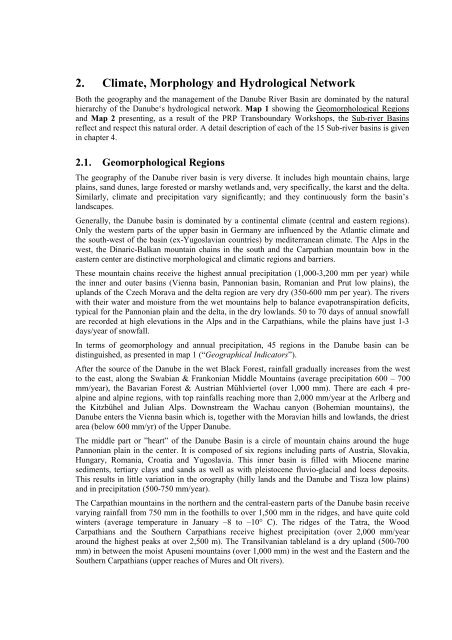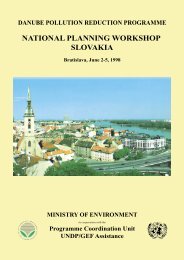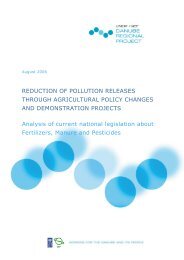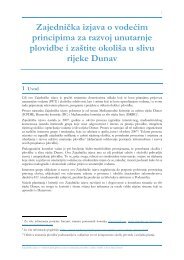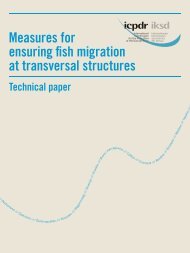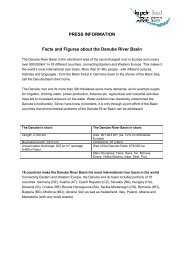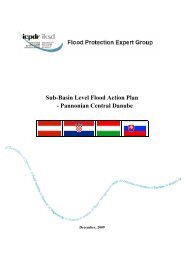Thematic Maps of the Danube River Basin - ICPDR
Thematic Maps of the Danube River Basin - ICPDR
Thematic Maps of the Danube River Basin - ICPDR
Create successful ePaper yourself
Turn your PDF publications into a flip-book with our unique Google optimized e-Paper software.
2. Climate, Morphology and Hydrological Network<br />
Both <strong>the</strong> geography and <strong>the</strong> management <strong>of</strong> <strong>the</strong> <strong>Danube</strong> <strong>River</strong> <strong>Basin</strong> are dominated by <strong>the</strong> natural<br />
hierarchy <strong>of</strong> <strong>the</strong> <strong>Danube</strong>‘s hydrological network. Map 1 showing <strong>the</strong> Geomorphological Regions<br />
and Map 2 presenting, as a result <strong>of</strong> <strong>the</strong> PRP Transboundary Workshops, <strong>the</strong> Sub-river <strong>Basin</strong>s<br />
reflect and respect this natural order. A detail description <strong>of</strong> each <strong>of</strong> <strong>the</strong> 15 Sub-river basins is given<br />
in chapter 4.<br />
2.1. Geomorphological Regions<br />
The geography <strong>of</strong> <strong>the</strong> <strong>Danube</strong> river basin is very diverse. It includes high mountain chains, large<br />
plains, sand dunes, large forested or marshy wetlands and, very specifically, <strong>the</strong> karst and <strong>the</strong> delta.<br />
Similarly, climate and precipitation vary significantly; and <strong>the</strong>y continuously form <strong>the</strong> basin’s<br />
landscapes.<br />
Generally, <strong>the</strong> <strong>Danube</strong> basin is dominated by a continental climate (central and eastern regions).<br />
Only <strong>the</strong> western parts <strong>of</strong> <strong>the</strong> upper basin in Germany are influenced by <strong>the</strong> Atlantic climate and<br />
<strong>the</strong> south-west <strong>of</strong> <strong>the</strong> basin (ex-Yugoslavian countries) by mediterranean climate. The Alps in <strong>the</strong><br />
west, <strong>the</strong> Dinaric-Balkan mountain chains in <strong>the</strong> south and <strong>the</strong> Carpathian mountain bow in <strong>the</strong><br />
eastern center are distinctive morphological and climatic regions and barriers.<br />
These mountain chains receive <strong>the</strong> highest annual precipitation (1,000-3,200 mm per year) while<br />
<strong>the</strong> inner and outer basins (Vienna basin, Pannonian basin, Romanian and Prut low plains), <strong>the</strong><br />
uplands <strong>of</strong> <strong>the</strong> Czech Morava and <strong>the</strong> delta region are very dry (350-600 mm per year). The rivers<br />
with <strong>the</strong>ir water and moisture from <strong>the</strong> wet mountains help to balance evapotranspiration deficits,<br />
typical for <strong>the</strong> Pannonian plain and <strong>the</strong> delta, in <strong>the</strong> dry lowlands. 50 to 70 days <strong>of</strong> annual snowfall<br />
are recorded at high elevations in <strong>the</strong> Alps and in <strong>the</strong> Carpathians, while <strong>the</strong> plains have just 1-3<br />
days/year <strong>of</strong> snowfall.<br />
In terms <strong>of</strong> geomorphology and annual precipitation, 45 regions in <strong>the</strong> <strong>Danube</strong> basin can be<br />
distinguished, as presented in map 1 (“Geographical Indicators”).<br />
After <strong>the</strong> source <strong>of</strong> <strong>the</strong> <strong>Danube</strong> in <strong>the</strong> wet Black Forest, rainfall gradually increases from <strong>the</strong> west<br />
to <strong>the</strong> east, along <strong>the</strong> Swabian & Frankonian Middle Mountains (average precipitation 600 – 700<br />
mm/year), <strong>the</strong> Bavarian Forest & Austrian Mühlviertel (over 1,000 mm). There are each 4 prealpine<br />
and alpine regions, with top rainfalls reaching more than 2,000 mm/year at <strong>the</strong> Arlberg and<br />
<strong>the</strong> Kitzbühel and Julian Alps. Downstream <strong>the</strong> Wachau canyon (Bohemian mountains), <strong>the</strong><br />
<strong>Danube</strong> enters <strong>the</strong> Vienna basin which is, toge<strong>the</strong>r with <strong>the</strong> Moravian hills and lowlands, <strong>the</strong> driest<br />
area (below 600 mm/yr) <strong>of</strong> <strong>the</strong> Upper <strong>Danube</strong>.<br />
The middle part or ”heart” <strong>of</strong> <strong>the</strong> <strong>Danube</strong> <strong>Basin</strong> is a circle <strong>of</strong> mountain chains around <strong>the</strong> huge<br />
Pannonian plain in <strong>the</strong> center. It is composed <strong>of</strong> six regions including parts <strong>of</strong> Austria, Slovakia,<br />
Hungary, Romania, Croatia and Yugoslavia. This inner basin is filled with Miocene marine<br />
sediments, tertiary clays and sands as well as with pleistocene fluvio-glacial and loess deposits.<br />
This results in little variation in <strong>the</strong> orography (hilly lands and <strong>the</strong> <strong>Danube</strong> and Tisza low plains)<br />
and in precipitation (500-750 mm/year).<br />
The Carpathian mountains in <strong>the</strong> nor<strong>the</strong>rn and <strong>the</strong> central-eastern parts <strong>of</strong> <strong>the</strong> <strong>Danube</strong> basin receive<br />
varying rainfall from 750 mm in <strong>the</strong> foothills to over 1,500 mm in <strong>the</strong> ridges, and have quite cold<br />
winters (average temperature in January –8 to –10° C). The ridges <strong>of</strong> <strong>the</strong> Tatra, <strong>the</strong> Wood<br />
Carpathians and <strong>the</strong> Sou<strong>the</strong>rn Carpathians receive highest precipitation (over 2,000 mm/year<br />
around <strong>the</strong> highest peaks at over 2,500 m). The Transilvanian tableland is a dry upland (500-700<br />
mm) in between <strong>the</strong> moist Apuseni mountains (over 1,000 mm) in <strong>the</strong> west and <strong>the</strong> Eastern and <strong>the</strong><br />
Sou<strong>the</strong>rn Carpathians (upper reaches <strong>of</strong> Mures and Olt rivers).


